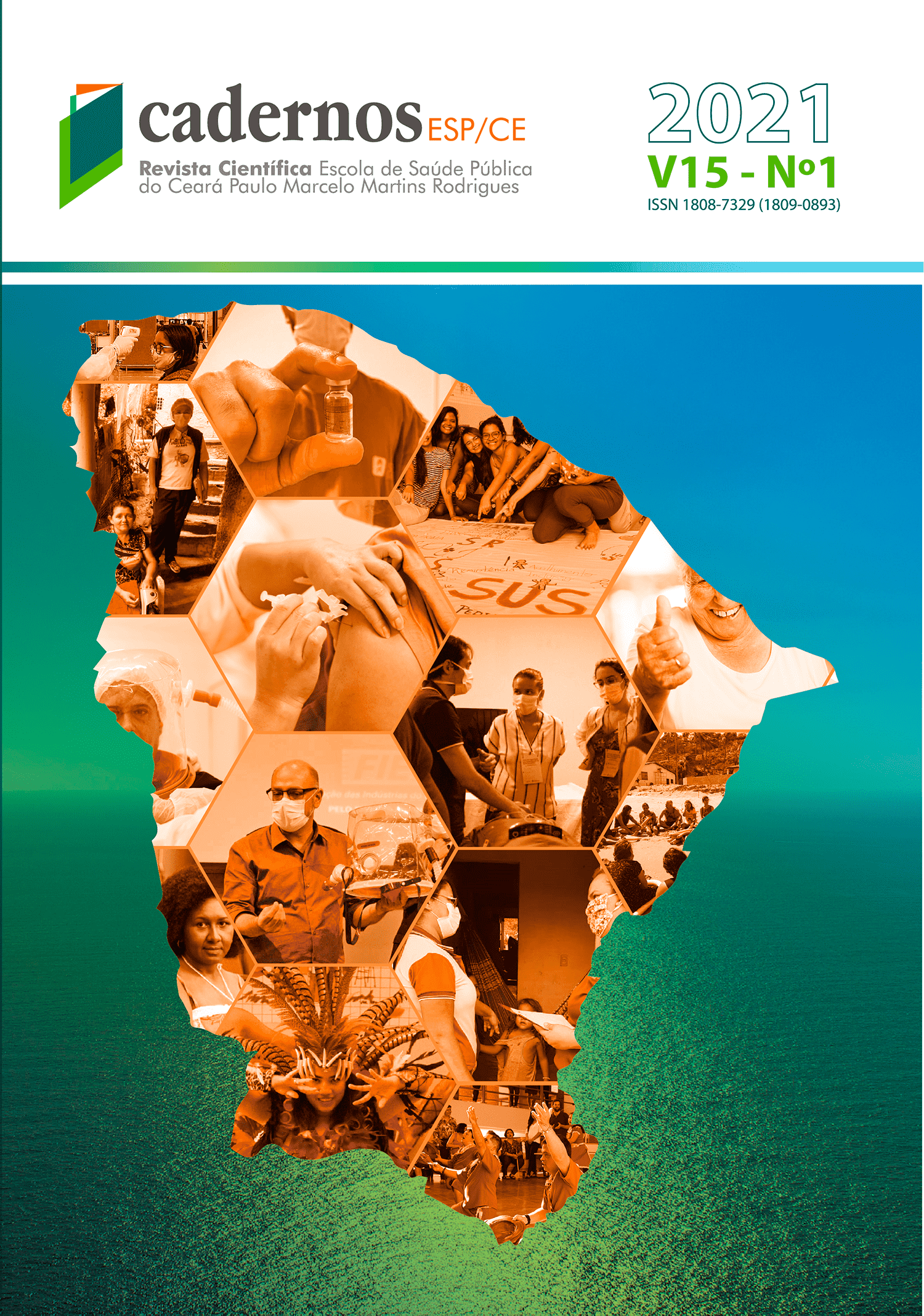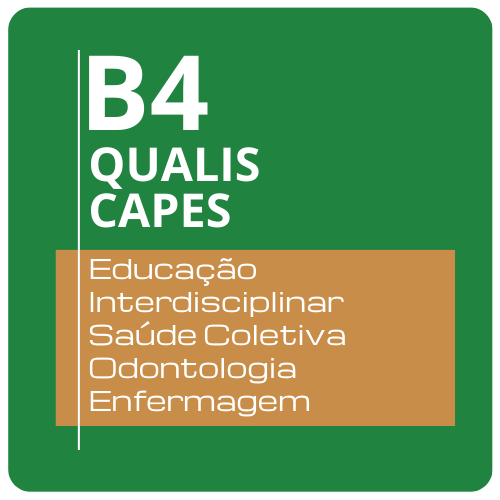NECESSIDADE DE TRATAMENTO ORTODÔNTICO NO CENTRO DE ESPECIALIDADES ODONTOLÓGICAS DE SOBRAL - CEARÁ
Palavras-chave:
Má Oclusão, Epidemiologia, Saúde PúblicaResumo
O objetivo deste estudo foi determinar a necessidade normativa de tratamento ortodôntico dos pacientes atendidos no Centro de Especialidades Odontológicas (CEO) e correlacionar com sexo, dentição, idade e dados referentes ao munícipio de origem do paciente. Foram avaliadas 438 documentações ortodônticas, de pacientes com idade entre 6 e 12 anos, adotando critérios estabelecidos pelo Índice de Necessidade de Tratamento Ortodôntico (IOTN). Os dados foram expressos em forma de frequência absoluta e percentual, comparados pelo teste Qui-quadrado de Pearson ou Exato de Fisher, com confiança de 95%. Observou-se que 72,6% dos pacientes apresentaram grande necessidade de tratamento ortodôntico. Não houve associação estatisticamente significante entre o índice de necessidade de tratamento ortodôntico com a dentição (p=0.059), sexo (p=0.998), idade (p=0.253), IDH (p=0.749) e taxa de cobertura das equipes de saúde bucal do município de origem do paciente (p=0.898). Concluiu-se que a maioria dos pacientes apresenta grande necessidade de tratamento ortodôntico e que esta necessidade não sofre influência de fatores sociodemográficos.
Downloads
Referências
2. Brasil. Ministério da Saúde. Diretrizes da Política Nacional de Saúde Bucal. Brasília: Ministério da Saúde; 2004.
3. Brasil. Secretaria de Atenção à Saúde. Departamento de Atenção Básica. Coordenação Geral de Saúde Bucal. Portaria n. 718/SAS/MS, de 20 de dezembro de 2010. Nota Técnica Ministerial. Brasília (DF); 2010.
4. Freitas MR, Freitas DS, Pinheiro FHSL, Freitas KMS. Prevalência das más oclusões em pacientes inscritos para tratamento ortodôntico na faculdade de odontologia de Bauru – USP. Rev Fac Odontol Bauru. 2002; 10(3):164-169.
5. Frazão P, Narvai PC, Latorre MRDO, Castellanos RA. Are severe occlusal problems more frequent in perma¬nent than deciduous dentition? Rev Saude Publica. 2004; 38(2): 247-254.
6. Dias PF, Gleiser R. Orthodontic treatment need in a group of 9-12-year-old Brazilian schoolchildren. Braz Oral Res. 2009; 23(2):182-189.
7. Brandão, GAM, Ferreira LL, Pereira AC, Brandão AMM, Almeida HÁ, Meneghim MC. A importância das características epidemiológicas e de qualidade de vida na determinação das necessidades de tratamento ortodôntico em saúde pública. Ortho Science. 2010; 3(12):274-380.
8. Freitas CV, Souza JGS, Mendes DC, Pordeus IA, Jones KM, Martins AMEBL Necessidade de tratamento ortodôntico em adolescentes brasileiros: avaliação com base na saúde pública. Rev Paul Pediatr. 2015; 33(2):204-210.
9. Laganà G, Abazi Y, Nastasi EB, Vinjolli F, Fabi F, Divizia M, Cozza P. Oral health conditions in an Albanian adolescent population: an epidemiological study. BMC Oral Health. 2015; 15:67.
10. Capote TSO. Avaliação da severidade de má oclusão de acordo com o gênero, idade e tipo de escola em crianças de 6 a 12 anos residentes na cidade de Araraquara. R Dental Press Ortodon Ortop Facial. 2003; 8(2):57-61.
11. Josefsson E, Bjerklin K, Lindsten R. Malocclusion frequency in Swedish and immigrant adolescents —influence of origin on orthodontic treatment need. Eur J Orthod. 2007; 29:79–87.
12. Christopherson EA, Briskie D, Inglehart MR, Habil P. Objective, Subjective, and Self-Assessment of Preadolescent Orthodontic Treatment Need – A Function of Age, Gender, and Ethnic/Racial Background? J Public Health Dent. 2009; 69(1):9-17.
13. Brizon VSC, Cortellazzi KL, Vazquez FL, Ambrosano GMB, Pereira AC, Gomes VE, Oliveira AC. Fatores individuais e contextuais associados à má oclusão em crianças brasileiras. Rev Saude Publica. 2013; 47(3):118-128.
14. Diwan S, Kumar S, Saxena V, Goel D. Assessment of orthodontic treatment needs among children in Doiwala region, Uttarakhand, India. National Journal of Community Medicine. 2013; 4(2):208-211.
15. Al Jeshi A, Al-Mulla A, Ferguson DJ. Orthodontic Treatment Need in Dubai School Adolescents: A Study of 20,000 School-age Adolescents in 66 Public and Private Schools Comparing Orthodontic Treatment Need by Gender and Ethnicity. Oral Health Dent Manag. 2014; 13(3):857-865.
16. Chaitra K, Reddy N, Reddy S, Vanishree. Orthodontic Treatment: Need and Demand in North Karnataka School Children. J Clin Diagn Res. 2014; 8(5):37–42.
17. Sanadhya S, Chadha M, Chaturvedi MK, Chaudhary M, Lerra S, Meena MK, Bakutra G, Acharya S, Pandey A, Tak M, Asawa K, Kamate S. Prevalence of malocclusion and orthodontic treatment needs among 12–15-year-old schoolchildren of fishermen of Kutch coast, Gujarat, India. Int Marit Health. 2014; 65(3):106–113.
18. Janoševic P, Stošic M, Janoševic M, Radojicic J, Filipovic G, Cutovic T. Index of orthodontic treatment need in children from the Niš Region. Vojnosanit Pregl. 2015; 72(1):12–15.
19. Santos Junior VE, Freire PLL, Alencar Filho AV, Heimer MV, Rosenblatt A. Orthodontic treatment needs in children and its relationship with gender, family income and ethnic groups. Rev Cubana Estomatol. 2016; 53(1):19-27.
20. Silveira MF, Freire RS, Nepomuceno MO, Martins AMEBL, Marcopito LF. Gravidade da maloclusão em adolescentes: estudo de base populacional no norte de Minas Gerais, Brasil. Rev Saude Publica [periódico na internet]. 2016 maio [acessado 2016 Jun 18];50(11): [cerca de 11 p.]. Disponível em: http://www.scielo.br/pdf/rsp/v50/pt_0034-8910-rsp-S151887872016050005861.pdf
21. Brook PH, Shaw WC. The development of an index of orthodontic treatment priority. Eur J Orthod. 1989; 11(3):309-320.
22. Dias PF, Gleiser R. O índice de necessidade de tratamento ortodôntico como um método de avaliação em saúde pública. R Dental Press Ortodon Ortop Facial. 2008; 13(1):74-81.
23. Dean JA, McDonald SM, Walker PO. Public assistance orthodontic treatment needs: a report from the state of Indiana. J Public Health Dent. 2005; 65(3):133 137.
24. Üçüncü N, Ertugay E. The Use of the Index of Orthodontic Treatment Need (IOTN) in a School Population and Referred Population. J Orthod. 2001; 28(1): 45-52.
25. Chew MT, Aw AKL. Appropriateness of orthodontic referrals: self-perceived and normative treatment needs of patients referred for orthodontic consultation. Community Dent Oral Epidemiol. 2002; 30(6): 449-454.
26. Handam AH. The relationship between patient, parent and clinician perceived need and normative orthodontic treatment need. Eur J Orthod. 2004; 26(3):265–271.
27. Bourne CO, Balkaran R, Scott E. Orthodontic treatment needs in Caribbean dental clinics. Eur J Orthod. 2012; 34(4):525-530.
28. Willems G, De Bruyne I, Verdonck A, Fieuws S, Carels C. Prevalence of dentofacial characteristics in a Belgian orthodontic population. Clin Oral Investig. 2001; 5:220–226.
29. Väkiparta MK, Kerosuo HM, Nyström ME, Heikinheimo KAK. Orthodontic Treatment Need from Eight to 12 Years of Age in an Early Treatment Oriented Public Health Care System: A Prospective Study. Angle Orthod. 2005; 75(3):344-349.
30. Kolawole KA, Otuyemi OD, Jeboda SO, Umweni AA. The need for orthodontic treatment in a school and referred population of Nigeria using the index of orthodontic treatment need (IOTN). Odontostomatol Trop. 2008; 31(122): 11-19.
31. Miguel JAM, Sales HX, Quintão CC, Oliveira, BH, Feu D. Factors associated with orthodontic treatment seeking by 12–15-year-old children at a state university-funded clinic. J Orthod. 2010; 37:100-106.
32. Santos NR, Cabo I, Almeida F, Castro S, Ponces MJ, Lopes JD. Aplicação do índice de necessidade de tratamento ortodôntico numa população ortodôntica portuguesa. Rev Port Estomatol Cir Maxilofac. 2014; 55(3):159-166.
33. Brasil. Ministério da Saúde. Secretaria de Atenção à Saúde. Departamento de Atenção Básica. Projeto SB Brasil 2003: condições de saúde bucal da população brasileira 2002-2003: resultados principais. Brasília: Ministério da Saúde.
Downloads
Publicado
Como Citar
Edição
Seção
Categorias
Licença
Copyright (c) 2021 Cadernos ESP

Este trabalho está licenciado sob uma licença Creative Commons Attribution 4.0 International License.
Accepted 2021-03-31
Published 2021-03-31























